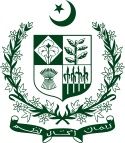
Back পাকিস্তানের সাধারণ নির্বাচন, ১৯৭৭ Bengali/Bangla Parlamentswahlen in Pakistan 1977 German Elecciones generales de Pakistán de 1977 Spanish Élections législatives pakistanaises de 1977 French Pemilihan umum Pakistan 1977 ID Парламентские выборы в Пакистане (1977) Russian پاکستان کے عام انتخابات 1977ء Urdu 第2屆巴基斯坦下議院選舉 ZH-YUE
| ||||||||||||||||||||||
200 of the 216 seats in the National Assembly 101 seats needed for a majority | ||||||||||||||||||||||
|---|---|---|---|---|---|---|---|---|---|---|---|---|---|---|---|---|---|---|---|---|---|---|
| ||||||||||||||||||||||
 Results by constituency | ||||||||||||||||||||||
| ||||||||||||||||||||||
| ||
|---|---|---|
Elections Political parties
Foreign Minister President of Pakistan Prime Minister of Pakistan
Downfall Bibliography Gallery: Picture, Sound, Video |
||
 |
|---|
|
|
General elections were held in Pakistan on 7 March 1977 to elect 200 members of the National Assembly.[1] They were the second general elections held in Pakistan and the first to be held after the Bangladesh Liberation War.
Although the elections were initially scheduled to be held in the second half of 1977 after the completion of the National Assembly's parliamentary term, the Pakistan People's Party (PPP) government led by Zulfikar Ali Bhutto decided to hold the elections earlier. As the majority of general public had a favourable opinion of Bhutto government, it was widely anticipated that the PPP would be re-elected.[2] In response, nine opposition parties united together to form the Pakistan National Alliance (PNA). The PNA ran on a right-wing platform, opposing the PPP's left-wing stance. However, the PNA also consisted of some left-wing parties that opposed Bhutto, including the National Awami Party of Khan Abdul Wali Khan, who was also regarded as the leader of the PNA.
The result was a landslide victory for the PPP, which won 155 seats. Meanwhile, the PNA won only 36 seats; the Pakistan Muslim League (Qayyum) was the only other party to win a seat. The PPP's victory meant Bhutto would continue as Prime Minister. However, the PNA accused the PPP of rigging the elections, and refused to accept the result. Although allegations of rigging were denied by PPP, the claims made by PNA sparked unrest that resulted in mass demonstrations and violent anti-Bhutto protests. Bhutto and the security forces were unable to control the situation and the government was forced to declare martial law. The Chief of Army Staff Muhammad Zia-ul-Haq subsequently called a secret meeting of senior military officials to plan a coup, which was successfully executed, resulting in the overthrow of government and dissolution of the National Assembly. Subsequently, Pakistan entered its third period of military rule.[3]
- ^ Dieter Nohlen, Florian Grotz & Christof Hartmann (2001) Elections in Asia: A data handbook, Volume I, p673 ISBN 0-19-924958-X
- ^ Bhutto and the 1977 coup The News, 9 July 2017
- ^ General Elections 1977 Story of Pakistan




